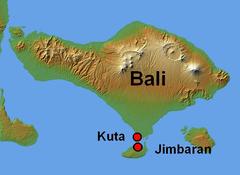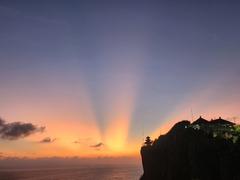Pura Luhur Uluwatu: Visiting Hours, Tickets, and Travel Guide – Badung, Indonesia
Date: 14/06/2025
Introduction: The Majesty and Significance of Pura Luhur Uluwatu
Perched atop a soaring limestone cliff approximately 70 meters above the Indian Ocean, Pura Luhur Uluwatu is one of Bali’s most revered sea temples and a striking testament to the island’s spiritual and architectural heritage. With its panoramic ocean views, intricate Balinese design, and deep religious importance, this temple is both a cultural landmark and a place of worship. The name “Uluwatu” comes from “ulu” (end or top) and “watu” (rock), reflecting its dramatic location on the southwestern tip of Bali’s Bukit Peninsula in Badung Regency (Wikipedia; saribalitour.com).
Founded as early as the 9th century and expanded in the 11th and 15th centuries by notable religious figures Empu Kuturan and Dang Hyang Nirartha, Pura Luhur Uluwatu has played a pivotal role in shaping Balinese Hindu traditions and remains one of the island’s nine key directional temples (kura2bus.com; budayabali.com). Its unique blend of natural grandeur, religious function, and artistic mastery makes it a must-visit destination for travelers seeking both beauty and meaning.
Table of Contents
- Origins and Historical Development
- Architectural and Spiritual Features
- Religious Significance and Rituals
- Visitor Information: Hours, Tickets, and Tips
- Folklore, Guardianship, and Community Role
- Enduring Legacy and Contemporary Importance
- Architectural Features and Layout
- Visiting Uluwatu Temple: Practical Information
- Kecak Dance at Pura Luhur Uluwatu
- Frequently Asked Questions (FAQ)
- Summary & Key Visitor Tips
- References and Further Reading
Origins and Historical Development
Pura Luhur Uluwatu’s origins trace back over a thousand years, with the earliest shrine believed to have existed in the 9th century (saribalitour.com). The temple gained prominence in the 11th century due to the spiritual reforms of Empu Kuturan, who unified various Balinese religious sects and established the Kahyangan Tiga temple system, a cornerstone of Balinese Hinduism (Wikipedia; kura2bus.com).
The temple’s spiritual stature was elevated in the 15th century by Dang Hyang Nirartha, a Javanese Hindu priest who is said to have attained moksha (spiritual liberation) at Uluwatu. The event, known locally as “ngeluhur,” gave rise to the temple’s “Luhur” epithet (saribalitour.com). The temple’s ancient entrance and shrines are enduring symbols of Bali’s religious and architectural continuity.
Architectural and Spiritual Features
Pura Luhur Uluwatu is a masterpiece of Balinese temple architecture, designed in harmony with its cliffside environment. Key structures include the three-tiered Meru (shrine), subsidiary temples, and intricately carved stone gateways (budayabali.com). The temple exemplifies the Tri Hita Karana philosophy, emphasizing balance among humans, nature, and the divine (kura2bus.com).
The site features layered courtyards—Nista Mandala (outer), Madya Mandala (middle), and Utama Mandala (inner)—that symbolically guide visitors from the secular to the sacred. Its dramatic clifftop walkways offer sweeping ocean vistas, while the temple’s stone carvings and statues depict gods, guardians, and mythological scenes (top10placestovisitintheworld.com).
Religious Significance and Rituals
Dedicated to Sang Hyang Widhi Wasa in his form as Rudra, the god of storms and the sea, Pura Luhur Uluwatu serves as a spiritual bulwark against negative forces from the ocean (Wikipedia; kura2bus.com). As one of the Sad Kahyangan Jagad (the island’s six or nine key temples), it is central to Bali’s spiritual protection.
Major ceremonies include the Melasti purification ritual before Nyepi (Balinese Day of Silence), when sacred objects are taken to the sea for cleansing (kura2bus.com). Daily offerings and prayers by the local community maintain the temple’s sanctity (budayabali.com).
A highlight for visitors is the daily sunset Kecak Dance, which dramatizes the Ramayana epic with hypnotic chanting and storytelling (kecakdanceuluwatu.com).
Visitor Information: Hours, Tickets, and Tips
Opening Hours:
- Daily from 07:00 to 19:00 (Water Sports Bali)
Entrance Fees (as of March 2025):
- International tourists: IDR 50,000/adult, IDR 30,000/child
- Domestic tourists: IDR 30,000/adult, IDR 20,000/child
(Water Sports Bali)
Kecak Dance Tickets:
- IDR 150,000–200,000/person; book in advance for best seats
(kecakdanceuluwatu.com)
Dress Code:
- Sarongs and sashes (provided at entrance), shoulders and knees covered
- Respectful behavior; avoid loud conversation and public displays of affection
Facilities:
- Restrooms, parking, small shops, viewing platforms, sarong rental (included), and on-site assistance
Accessibility:
- The temple grounds have uneven terrain and stairs; limited options for visitors with mobility impairments
Tips:
- Arrive by 16:00 for sunset and Kecak dance
- Bring cash, sun protection, and secure valuables (monkeys present)
(News CannaBali)
Folklore, Guardianship, and Community Role
Local legend claims the cliff is part of Dewi Danu’s petrified barque, lending a mystical aura to the site (Wikipedia). The resident long-tailed macaques are believed to be spiritual guardians, though they are notorious for their mischief—keep your belongings close! The temple is cared for by the Pecatu village community, who uphold its ceremonies and traditions (budayabali.com).
Enduring Legacy and Contemporary Importance
Despite centuries of exposure to the elements, Pura Luhur Uluwatu remains a vital symbol of Bali’s resilience and devotion. It continues to attract worshippers and travelers alike, serving as both a religious center and a cultural attraction. Its inclusion among Bali’s major tourism and spiritual sites highlights its enduring relevance (kura2bus.com; Wikipedia).
Architectural Features and Layout
Clifftop Setting and Nature Integration
The temple rises organically from the limestone cliff, embodying the Balinese principle of harmony with nature (top10placestovisitintheworld.com; balicheapesttours.com). The cliffside walkways offer sweeping ocean vistas and a meditative atmosphere (finnsbeachclub.com).
Temple Layout
The temple is divided into three zones—Nista Mandala (outer), Madya Mandala (middle), and Utama Mandala (inner)—representing a spiritual journey. The main shrine, dedicated to Rudra, can only be accessed by Hindu worshippers (balicheapesttours.com; travelpassionate.com).
Entrances & Gateways
Uluwatu Temple features north and south entrances, guarded by Ganesha statues and adorned with stone reliefs. The candi bentar (split gate) symbolizes the threshold to the sacred (travelpassionate.com; top10placestovisitintheworld.com).
Artistic Details
The temple’s walls, shrines, and gateways are decorated with intricate carvings depicting Hindu mythology and Balinese legends. Coral, limestone, and volcanic stone highlight the artisans’ craftsmanship (top10placestovisitintheworld.com).
Visiting Uluwatu Temple: Practical Information
- How to Get There: About 25 km from Kuta and 40 km from Ngurah Rai Airport; accessible by car, scooter, or tour (BaliTrekker; Water Sports Bali)
- Nearby Attractions: Padang Padang Beach, Dreamland Beach, Garuda Wisnu Kencana Cultural Park, and local cafés
Kecak Dance at Pura Luhur Uluwatu: Visiting Hours, Tickets & Cultural Insights
Experience:
The Kecak Dance is performed daily at sunset in an open-air amphitheater. The performance narrates a pivotal Ramayana episode with a chorus of up to 70 chanting men (kecakdanceuluwatu.com). Two shows (6:00 PM and 7:00 PM) are scheduled during peak seasons (Bali Holiday Secrets).
Tips:
- Book tickets in advance (Tiket.com)
- Arrive early for sunset views and best seating
- Modest dress and respectful behavior required
- Photography is allowed without flash
Frequently Asked Questions (FAQ)
Q: What are Uluwatu Temple’s opening hours?
A: 07:00–19:00 daily (Water Sports Bali)
Q: How much are tickets?
A: IDR 50,000/adult (international), Kecak Dance extra (Water Sports Bali)
Q: Is the temple accessible for people with limited mobility?
A: Accessibility is limited due to stairs and uneven paths.
Q: Can non-Hindus enter the main temple?
A: No, only the outer areas are open to non-Hindus.
Q: Are guided tours available?
A: Yes, many operators offer tours including temple visits and dance tickets.
Summary & Key Visitor Tips
Pura Luhur Uluwatu stands as a living testament to Bali’s spiritual and cultural richness, uniting ancient traditions, architectural splendor, and breathtaking natural views. The daily Kecak Dance at sunset epitomizes the island’s vibrant performing arts. For a memorable visit:
- Arrive early for sunset and Kecak Dance
- Dress respectfully; use provided sarong and sash
- Bring cash and sun protection
- Be mindful of monkeys and secure valuables
- Respect temple etiquette and local customs
For the latest information, schedules, and insider tips, download the Audiala app and follow related travel resources.
References and Further Reading
- Wikipedia
- saribalitour.com
- kura2bus.com
- budayabali.com
- travelpassionate.com
- Water Sports Bali
- News CannaBali
- kecakdanceuluwatu.com
- top10placestovisitintheworld.com
- balicheapesttours.com
- finnsbeachclub.com
- lostbetweenoceans.com
- raftingbali.net
- Tiket.com
- Bali Holiday Secrets
- BaliTrekker
- Trip.com



